A Day in the Life of an Area Winemaker, Dana Keeler
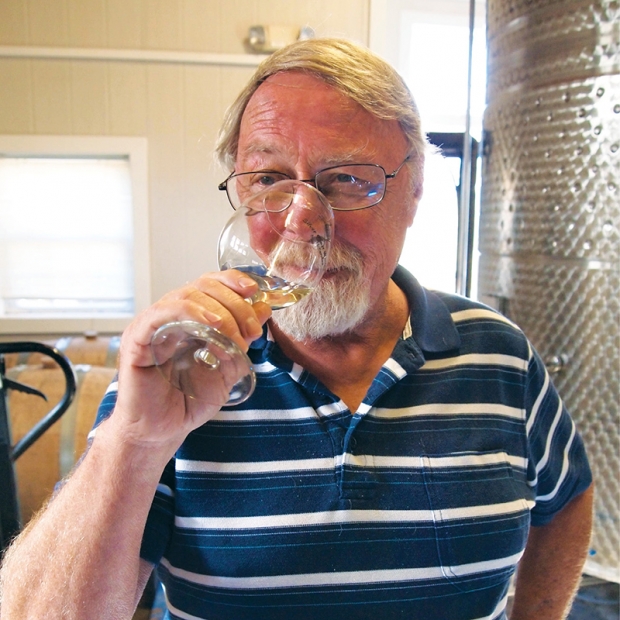
For nearly 50 years, Dana Keeler has been fine-tuning his skills as a winemaker, learning the importance of climate and soils in developing the nuance of a wine’s character, discerning a wine’s fitness for consumption through his nose, and tasting a wine’s fruitiness, tannins, acidity, finish, the subtlety of spice, dryness and sweetness. Keeler can blend and tweak like nobody’s business, creating award winning wines in the process, with the medals and accolades to prove it. He’s pretty handy around the shop, too.
First developing his skills under the tutelage of winemaking legends of the Finger Lakes region situated in the picturesque, bucolic hills of central New York, Keeler began as a laborer. He learned the trade from the ground up as a young man freshly home from the U.S. Army and service in Vietnam. In the mid-1970s, the Finger Lakes was just ramping up toward recognition as an AVA (American Viticulture Area), with just five or six wineries nestled among the 11 long, narrow glacier-formed Finger Lakes. After winemaking was taken seriously there, beginning in the late 1970s, the region began producing some fine, award-winning wines, and still does to this day.
After Keeler spent some 30 years in New York as a winemaker, and after “one snow storm too many,” the call of the Carolinas came in the form of Ocean Isle Beach’s Silver Coast Winery in North Carolina.
“Maryann Azzato (Silver Coast’s owner) hit me at a weak moment, and I said ‘yes,’” Keeler recalls of the move he made 18 years ago. It was a move he says he’s never regretted.
Keeler had been consulting in the Carolinas and knew Silver Coast and the region well before he uprooted his life, leaving freelancing behind, to once again become a fulltime winemaker.
While no two days are the same for Keeler, we were still curious as to what kinds of duties and challenges a winemaker might be responsible for on any given day. We recently spent a few hours at Silver Coast Winery, 15 minutes north of the Grand Strand, just over the state line into North Carolina, to try to understand if there was more to winemaking than just stomping grapes in one’s bare feet. No real surprise… it turns out there is.
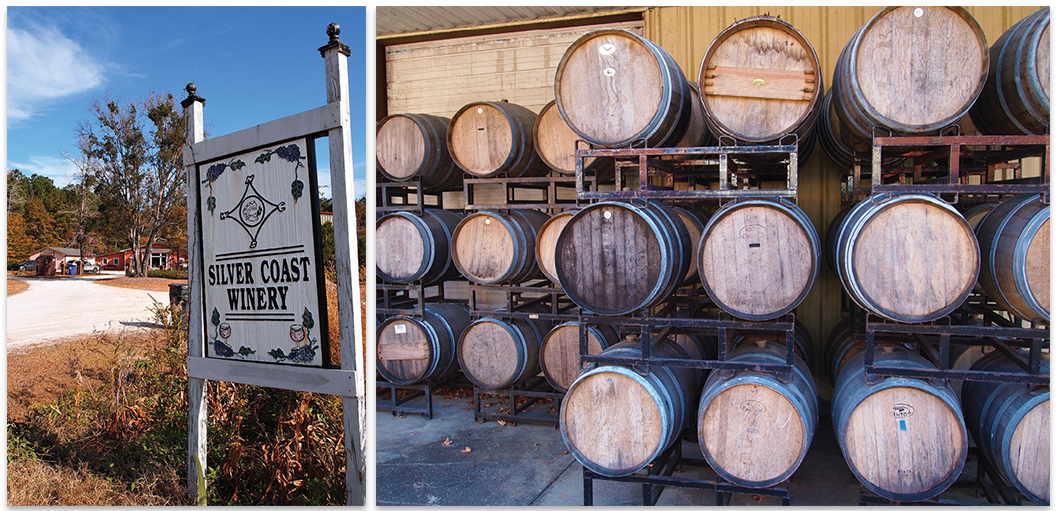
9:00 a.m.
I met Keeler before opening hours near the back door of the winery, once a popular barbecue restaurant called “Sim’s.” Silver Coast’s new owners had purchased the vacant property then reimagined, renovated, reengineered and added on, opening Silver Coast Winery in 2002. Just two years later, Keeler came aboard.
An amiable, compact and friendly man, Keeler, 70, enjoys reliving the history of his unusual profession and discussing, candidly, where and how he got his start in the day-to-day of a winemaking operation that produces, bottles and labels some 9,000 cases annually.
The Early Days
“I burned out in college {SUNY Corning Community College} after taking intensive math/science and organic chemistry courses on the G.I. Bill,” says Keeler, sipping from his morning coffee in The Charlotte Room, an auxiliary tasting room at Silver Coast.
“I served in Vietnam ’71 to ’74. They promised me I’d end up in Germany after training,” he continues, a wry smile forming at the memory of promises broken. “After the Army and school, I needed a break and thought I’d look to my own backyard for work: the vineyards of the Finger Lakes. One of the girls in my class worked in Hammondsport, N.Y., at Taylor.
Taylor had been in existence since the 1880s, failing only after corporate buyouts beginning in the 1970s. I, of course, knew of the wineries, but didn’t particularly like wine, but I decided to go to Hammondsport to see what that was all about and find a job,” says Keeler. “They wanted me to cut my hair–I had a ponytail back then, and I wasn’t about to do that.”
The Taylor Wine Company was once the largest winery of the region and now only exists as a brand. More than 100 small wineries now inhabit the Finger Lakes region, but none can compare in size and scope to the biggest during the region’s halcyon days, an era Keeler was front and center for.
“I interviewed at a few other Finger Lakes wineries and ended up at Bully Hill, ultimately becoming the head winemaker and general manager,” he says.
The intriguing history of the intermingling of the Taylor family heritage, clandestine nighttime deliveries of California grape juice via train tankards, lawsuits, gag orders, and court-mandated disassociations, is worthy of a Ken Burns docu-series. Keeler was there for much of the drama, dubbed locally as “The Coca Cola Wars,” in reference to Coca-Cola’s purchase of the company years earlier. Still, he was able to learn under Walter Taylor, the grandson of the original Taylor Wine family and then owner of startup Bully Hill. Keeler would end up at Herron Hill Vineyard before eventually leaving New York.
“All the really big wineries of the Finger Lakes are gone,” says Keeler. “Taylor, Gold Seal, Great Western–all gone, only existing as names.”
Keeler is still well known in the Finger Lakes winemaking circles, with a sphere of influence that took him well beyond south-central New York.
“By the time I had put in 20 years in the Finger Lakes,” says Keeler, “I was the ‘old man’ in the industry and kind of a hot commodity, so I began consulting, too.”
While in New York, Keeler learned very important lessons about grafting winter-hardy and disease-resistant rootstock of native grown grapes, such as the Concord, Niagara and Catawba, along with French, Mediterranean and other European vinifera. This practice started in the late 1800s and revolutionized winemaking in the region, especially when it was fine-tuned in the 1970s and 1980s to create world-class American hybrids, Chardonnays, Rieslings and other European varietals. Closer to home, the only native grape to the Carolina coastal region is the muscadine, and Keeler makes a lot of muscadine wines–not for Silver Coast Winery, but for its South Carolina neighbor, La Belle Amie Vineyard of North Myrtle Beach.
“La Belle Amie is easily our largest customer,” says Keeler. “They sell an awful lot of wine. In the early days of my living down here, I went to La Belle Amie to introduce myself. One thing led to another, and we’ve enjoyed a long partnership. We work together on European-style wines and blends, and, of course, we make and bottle a lot of the local favorite muscadine wine, too.”
The Mighty Muscadine Scuppernong—Vitis Rotundifolia
Though the muscadine is the bronze-to-green colored, thick-skinned and sweet grape seen growing at local vineyards, such as at Silver Coast and La Belle Amie, it represents only a part of the finished wines that are fermented, blended, bottled and sold locally. Silver Coast does not sell any muscadine wines, preferring to make and sell traditional, European styles, semi-dry and aged in oak barrels or stainless steel, depending on the varietal. La Belle Amie sells a large amount, and Duplin Winery, the largest winery and retail operation in the Carolinas, sells muscadine wines exclusively, but why?
“Due to an indigenous bacterial pathogen in this area, Xylella fastidiosa [Pierce’s Disease], that kills virtually all other grape varieties, the Muscadine evolved over time and developed an immunity,” says Keeler. “It tends to be very sweet, and people like sweet. Southerners like sweet tea, so I guess that’s a part of it. I refused to make muscadine for the longest time because I didn’t like it. It’s enormously popular, however, and I can appreciate a well-made muscadine, but it’s not to my taste. I’m seeing a shift toward [European-style] wines and less of the muscadine, but it’s still a big, big seller in the South.”
9:55 a.m.
After an informative and fascinating hour learning of Keeler’s history, and a lot about grapes and winemaking, we moved on.
We toured Silver Coast’s former Barrel Room, now an event room in high demand for weddings, line dance events, the bridge club, American Wine Society meetings, and other civic activities, where a large room adjacent to a lot of wine might be required.
“When I first got here, I had to figure out what to do with way too much wine,” says Keeler. “This room was filled with primarily Merlot and Cabernet Sauvignon in barrels. They had gotten a great deal on grapes and bought too many. I had to go through the barrels to determine just what to do with it all.”
Keeler determined which barrels would stay, which would go, and which would be blended through an organoleptic process; taste, sight, smell.
“Through this process you can determine what to do with wines that have characteristics that make them better suited to one style over another,” he explains. “One of the things that makes Covid so terrifying is the loss of taste and smell that can occur.” For anyone in Keeler’s line of business, that’s a game-ending issue, one he’s thankfully avoided.
“We get the bulk of our grapes from the southeast,” he continues. “They’re reflective of the wines of our region, with the exception of this coastal zone. I look to France for classic styles of the wines I like to make. Napa Valley has changed the complexion of Cabernets, New Zealand has changed the complexion of Sauvignon blanc, Argentina has changed Malbec—all grapes that first came from France.” So, too has Keeler made his mark with a Carolina-style of the classics. His wines have won more than 400 medals at competition.
With the operation comes paperwork, and there’s plenty to keep Keeler occupied. We briefly visit his office filled with dusty old bottles of wine, each known well and appreciated reverently for the time and place of its creation.
“This is a reserve merlot from 2002 I made when I first got here,” says Keeler. “It’s still really very good.”
I ask if wine can really age and still taste good.
“Yes, absolutely,” answers Keeler, picking up another dusty bottle. “This is a 1990 Chardonnay reserve that I did at Herman Weimer’s in the Finger Lakes. A certain batch of grapes came that I knew I wanted to do something special with. I just pulled the cork on this a week ago, some 31 years after bottling, and it’s beautiful, special, like a white burgundy. Still had fruit, nice character, was not oxidized at all, the color was only a little darker. I’ll admit, that one surprised me.”
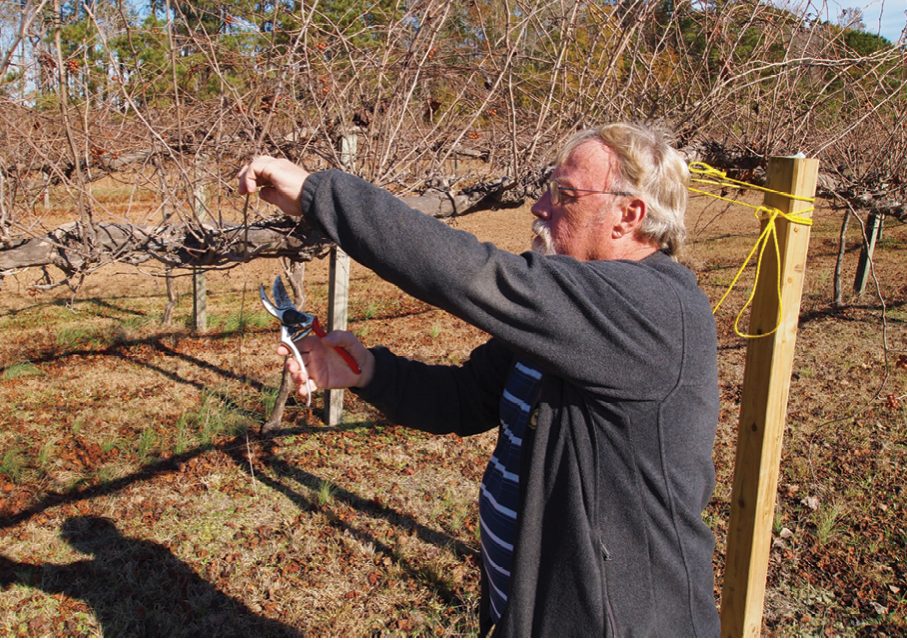
10:10 a.m.
The propane truck arrives with a delivery, another duty overseen by Keeler.
“I’ll have to get the fireplaces up and running shortly,” he says as we walk outside to meet the driver. “Then there’s a vacuum pump I have to replace on one of the machines.”
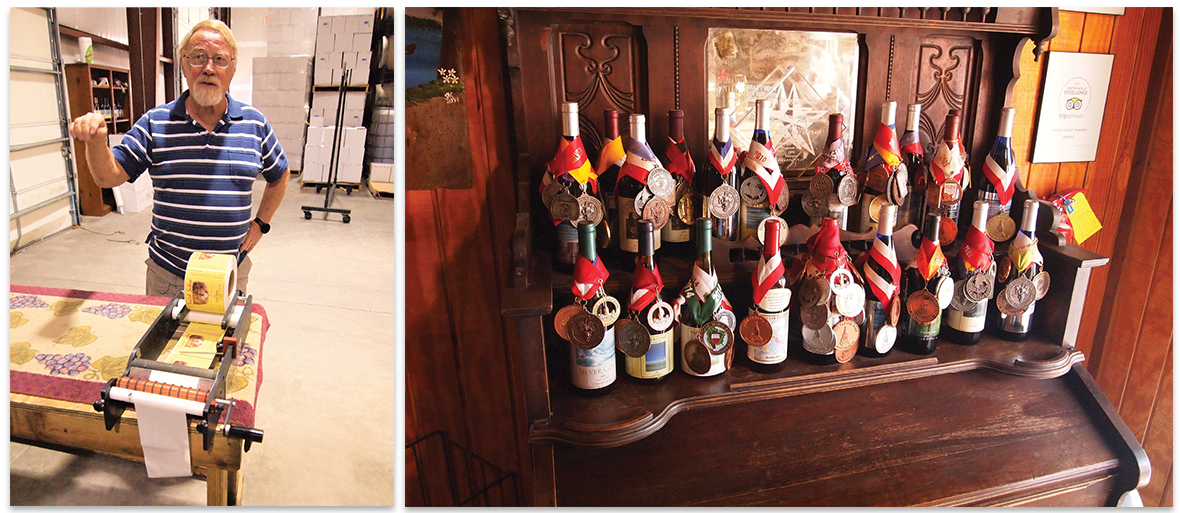
10:33 a.m.
In the warehouse, corked bottles of wine are getting capped with the signature red foil seal, called “capsules,” just before being labeled for La Belle Amie Vineyard’s Ice Queen brand of muscadine wine. Staffer Kevin Munn breezes through the process with skill that comes from repetition.
“I’m using a lot of synthetic corks,” adds Keeler. “There is the risk of loss from cork taint, the transfer of funky tastes to the wine from bad corks, when using natural cork, so we prefer the synthetics. They used to be made out of rubber, now they’re made from sugarcane.” The industry leader and Keeler’s supplier of carbon-neutral synthetic corks, Nomacorc, is located in nearby Zebulon, N.C.
10:50 a.m.
“I don’t have a big staff in to help me today,” says Keeler. September and October are his busiest months, as they represent harvest time and deliveries of grapes for processing—no stomping required, just pressing, crushing and stemming by machine. “Today I wanted to start pruning the vines. They need some attention, and I like to get outdoors.”
Outside on an unseasonably warm day, we walk through the grass to the rows of seasonally barren muscadine vines, gnarled and tough as nails at 20 years old and showing new growth that needed taming. The vines greet guests as they come in on the long, gravel road, eager for the wine tastings, the many events and the eclectic art, much of which is for sale. At harvest time, the pick-your-own crowd shows up for the plump, ripe muscadines.
“We’ve done pretty well through the pandemic,” says Keeler, who stays involved to one degree or another in many aspects of the business. “We have lots of outdoor spaces for people to congregate, and a trove of loyal locals who convene on the porches, front and back, to hold court, drink wine and socialize. Some days, my job is to sit on the porch and entertain.”
11:15 a.m.
In the tank room, massive stainless steel tanks, between 1,000 and 2,500 gallons each hold a wide variety wines, most ready to bottle.
“These wines are stable,” says Keeler, “but they have to be managed, that is, checking for sulfur levels.”
At the site of the malfunctioning vacuum pump on one of the many complicated pieces of winemaking machinery, Keeler reminds me that much is required of everyone when working at a small company.
“Back in the Finger Lakes, and even here, we can’t always wait for a mechanic to come and repair a piece of equipment,” he says. “If the machine’s not working, then we’re not making wine. You’ve got to be as self-sufficient as possible, so you learn to fix things yourself.”
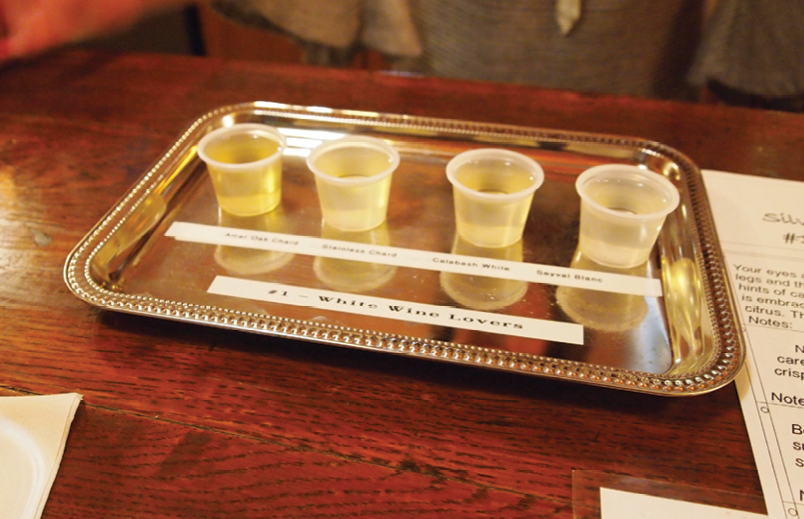
11:45 a.m.
Where better to end our day than in the tasting room with a flight of five wines? Like so many of Silver Coast’s customers, I, too, chose one of their bestsellers as my favorite. The American Chardonnay is crisp, bright, clean and on the dry side with notes of pears and apple skins. In a word: delicious.
Staffers Ann Morris and Jennifer Elliott await the first reservations of the day when the winery opens at 12-noon. Keeler sometimes assists in the wine tastings, a bonus offered to lucky customers who love to hear from the actual winemaker.
What’s your favorite wine, I felt compelled to ask?
“I have no one favorite,” says Keeler, not being disingenuous at all. “I enjoy all of them, and pairing with the foods you’re eating is all-important.”
Winemaking at Keeler’s level is a complicated, exacting, demanding endeavor, requiring ground-up training over the course of many years. Even then, as the industry changes and tastes change, there’s always something new to learn.
“I’m still learning. That’s the joy of this profession. It’s not a job, it’s a life, and it’s a life that I love.”
Visit Silver Coast Winery, and, if you’re lucky, you may get to meet and query Keeler, as he’s never too far away and always happy to talk wine.
Hours vary. Call first.
Silver Coast Winery
6680 Barbeque Road Northwest
Ocean Isle Beach, NC
(910) 287-2800
www.silvercoastwinery.com